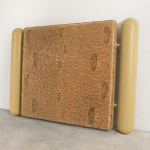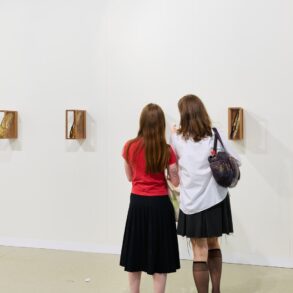More artists should keep diaries. While they can be deliciously revelatory, their pleasure mostly lies in the liberated quality of the writing. When writers keep diaries, the activity is freighted: this, after all, is their art form. Artists have a tendency to be less inhibited. Andy Warhol, for example, famously wrote down everything that happened to him; his diaries sometimes read like the society pages. Other artists record in painstaking detail the challenges—mental, emotional, physical—involved in the creative act. The diaries of sculptor Donna Dennis, set to be published later this month by Bamberger Books, fit this last category.
The diaries, Writing Toward Dawn: Selected Journals 1969-1982, come just as Dennis’s work is getting long overdue recognition. “Houses and Hotels,” a show of five major works, dating from 1967 to 1994, is currently on view at downtown New York’s O’Flahertys gallery; there are other presentations of Dennis’s work to follow elsewhere this year.
To read of the circumstances under which Dennis made the pieces featured in “Houses and Hotels” is gratifying. These large, complex architectural sculptures were pieced together in the limited space of her New York studio, sometimes lying on the floor under the artworks. But the challenge wasn’t only logistical. The works are also documentation of something far less timebound: the struggle to balance life—relationships, as well as practicalities like housing and money—with creative work. Like anyone fully engaging in creative activity, Dennis had to decide along the way where she would compromise in her life to make her art. As it should go without saying, it was harder during those years for a woman to do such a thing than it was for a man. Ironically, if it weren’t for one man in particular, she might never have kept her diaries in the first place.

Tourist Cabin Porch (Maine), Donna Dennis, 1976, Acrylic and enamel on wood and Masonite, glass, metal screen, fabric, incandescent light, sound, 6’6” x 6’10” x 2’2”.
Courtesy of the artist and O’Flaherty’s
Born and raised in the New York City suburb of Westchester, Dennis attended Carleton College in Minnesota in the early 1960s, then moved to Manhattan, amongst a social circle of fellow Carleton graduates like the late critic Peter Schjeldahl and the late painter Martha Diamond. Dennis, who was also a painter at that time, shared with the two of them an ambition that was apparent from the start. Another of their peers, the poet Anne Waldman, recalled in a New York Times obituary of Diamond earlier this year, “When you feel it with people who have this conviction already, it’s very much in them, and I felt that with Peter at an early age, and with Donna and with Martha.” Others in their social circle were poets, like Ron Padgett and Ted Berrigan, the latter of whom Dennis fell into a romantic relationship with. It was that relationship that gave birth to her journals. Arguably, the end of that relationship gave birth to her career.
“I was in kind of a major romantic thing with the poet Ted Berrigan, and Ted kept a journal,” Dennis told writer Nicole Miller in 2019. Dennis, too, started keeping a journal in the late ‘60s. Not surprisingly, it opens with a lot of talk of Berrigan: “While Ted is away I am drawing self-portraits”; “I am beginning to feel anxious about missing Ted.”; “I feel that maybe I’ve lost my mystery for Ted”; “I said to Ted, “It’s spring!”; “In the past week I’ve felt I really have come to understand what Ted was trying to tell me last year.”; “Ted says an artist never lets money come between him and his art.” She wonders who she is supposed to be at any given time: “One side of me wants to be so sensible & sane and respected that way—the other side of me wants to be weird and shocking—but not really that—more than that. One side of me wants to be a witch—a mystic, to be burned at the stake, to see the horrors of the universe, the vastness—to be a vehicle for that power—a vessel through which that power flows & makes itself manifest.” But then it’s back to Ted: “I am beginning to feel anxious about missing Ted.”
It’s only after the breakup with Berrigan that Dennis seems to come into herself. She reads The Feminine Mystique (“It’s changing my life at a time when I am open to change in a major way.”) She meets feminist critic Lucy Lippard. She joins a feminist consciousness-raising group, goes to marches. She has an affair with a woman artist (“Bisexuality appeals to me as an idea. Loving a woman seems a way to throw off the hurt and futility and bad habits of loving a man.”) She refreshes her wardrobe (“Bought dungarees today. Change in lifestyle.”) She enters the ‘70s with guns blazing (“finished The First Third by Neal Cassady. Sweet guy like Kerouac. Find myself envying them for their pleasure at their time (the ‘50s). Hope I’m getting as much from my time (the ‘60s) but no, I’m absolutely certain that this whole decade— the ‘70s—is mine—more than the ‘60s ever were.“) She finds her voice, her style: she starts making sculpture inspired by buildings she sees in the city, as well as in photographs by Walker Evans and George Tice, and in paintings by Edward Hopper.
The ‘70s were of course the heyday of second wave feminism in New York and artists were at the vanguard. The decade opened with Linda Nochlin’s famous article “Why Have There Been No Great Women Artists” in ARTnews; a group of downtown women artists, alongside critic Lucy Lippard, started a consciousness-raising group and the quarterly journal Heresies: A Feminist Publication on Art and Politics. It is all too easy to rely on sweeping accounts of how feminism changed things for women artists; it is much more affecting to read of the particulars. Dennis’s diary captures her real-time revelations both personal (“I like myself more and more because I accept myself as a woman more and more.”) and art-historical, the latter recorded in all-caps: “NOW I REALIZE HOW I’VE FELT CONTEMPT AT BOYS FOR SHUTTING ME OUT. FOR YEARS I’VE BEEN HAMMERING ON THE DOOR TO THE ROOM THE MEN LIVED IN (WITH MATISSE, PICASSO, KANDINSKY, CHOPIN). I’VE BEEN MANEUVERING MIRRORS TO ATTRACT THEIR ATTENTION WITH FLASHES OF THEIR OWN (SUN) LIGHT REFLECTED. “
She also sees the movement’s contradictions in action: “Everyone, it turned out, felt grotesquely fat and had treated their bodies horribly at times. No one is really fat. It seemed quite a devastating revelation that everyone was such a slave to a false conception of themselves, and yet—what ensued? A great ‘girl’ talk session on diets, hairdos, exercise, in fact a further acceptance of the horrors turned up.” And she notes the movement’s limitations. At one point, she faults her feminist consciousness-raising group for not being political enough. It’s “tainted by psychotherapy,” she writes. “I do not want to have to defend myself as a fucked-up person. I want to be able to give my testimony as an exploited female.”
Elsewhere in the diaries, however, she grapples with the demands that politics seem to put on her to choose sides: she takes her slides in for consideration for the Whitney Biennial, then learns that a group protesting the lack of women and people of color in the art world planned to pressure artists who participated in it. “Shit! The issue is having women’s work seen,” she writes. “So, what’s the point of intimidating women, anywhere, anytime, anyhow, who get a chance to show. I feel quite disturbed that a group for artists’ rights would take such a stand. Unless they were to organize an alternative show. I feel that this is going to be a year when women show their incredible power as artists. Power of demonstrations paltry compared with the power of the work. Once it is seen no one will ever be able to discuss women artists (or black artists) again in the same way.”

Tourist Cabin with Folded Bed, Donna Dennis, 1986 Mixed media, 6’6″ x 4’6″ x 6′.
Courtesy of the artist and O’Flaherty’s
Dennis wasn’t making art whose subject matter was overtly feminist; she was innovating architectural sculpture alongside the likes of Alice Aycock. Nevertheless, the influence of feminism becomes apparent in the way she thinks of her work, leavened by her unique sense of humor: “The door is also a kind of vagina and I’ve always thought of my works as kind of mantraps,” she writes. “So it’s a woman’s joke on men. The works are my size (height). The scale of my works once they started coming into the room (marked by the birth of the box) has always been measured and determined by human scale. The painted world behind the box was 10′ × 7′, designed to engulf the viewer (who I REALIZE I HAVE ALWAYS THOUGHT OF AS MALE). I wanted to overwhelm him. So I see now I’ve developed a sense of confidence and humor on the subject of male/female relationships.”
If being an artist in downtown New York during those years sounds romantic, the diaries reflect that. In one memorable entry, Dennis finds ways around the police not letting her take photos of a structure at the entrance to the Holland Tunnel that she is using as inspiration for a sculpture. In another, she cries at the sight of Matisse’s sketches for the windows at Venice cathedral.
But the entries are also filled with banalities. Dennis takes care of her cats, cleans and “de-roaches” her apartment; she moves her bed so she can hear the street sounds at night. She wonders how she will pay December’s rent. She takes menial jobs that pay $2.00 an hour. She starts and leaves a department store job, all in one day, in an account that serves as a time capsule of ‘70s Manhattan:
“[H]ad a great night. Did a really good, new drawing. Slept a couple of hours. Got up, went to Bloomingdale’s totally shot. It was horrible. Thirty of us in a tiny claustrophobic classroom that reminded me of the worst first days in high school. The teacher referred to women as “girls.” Then she started asking people to get up in front of everyone and gave them problems to work out on the computer-register. The first person shook so much she could hardly touch the keys. My mind went numb (it already was pretty much so) and I just waited for lunch. By then I was in a daze. Went to Bonwit’s in the rain (my umbrella wouldn’t open right), called my answering service—the two freelance jobs I’d been hoping for hadn’t materialized. Cashed a bad check for $10. I’d spent my last money the day before. Ate lunch at MoMA. (I hardly could.) Walked around trying to figure out what to do.”
Throughout the journals the reader accompanies Dennis on visits—sometimes alone, sometimes with a friend or lover—to the apartment studio of her friend, the Russian-born Social Realist painter Raphael Soyer, who, in his 70s, serves as a kind of mentor figure. Dennis admires his work ethic (“Raphael pointed out that he is in his studio every day by 9:30 and leaves at 5:30. Even New Year’s Day and Jewish holidays, he said! So there’s my inspiration. “) They discuss the status of the artist. “At Raphael’s today we talked about the place of the artist in our society,” she writes, “We agreed that the artist has a very small, inconsequential place in society today. Most people get along without it. I mentioned commercial art, films, TV. Warhol is really the least romantic of us all. The artist today must be a star rather than a workman. Warhol and his ordinary ‘stars.’ Raphael says he can respect his cynicism.”
At the same time, the Soyer sessions prompt revelations about how women’s art might be important to all women: “After some silent musing, I told Raphael that I felt that art could mean a lot to people just beginning to discover themselves. Really, I was thinking of women. Nearly every woman who is becoming aware is watching, waiting, listening to see who we are. What we are like. And so, for a woman, women’s art (unless it tries to be men’s art) is of everyday importance.”
As much as he’s a wise elder and a sounding board, Soyer also provides a kind of mirror for Dennis as she evolves. In 1981, she writes of a visit to him, ““You’re a very strong woman,” he said. He said I seemed “very lost” at one time. Not quite but certainly I was troubled and have come a long way.”

Cataract Cabin, Donna Dennis, 1994, Acrylic and enamel on wood and Masonite with glass, metal, grout, rope, pump, water, mirror, 12’ x 12’ x 12’.
Courtesy of the artist and O’Flaherty’s
The struggle of the starving artist is present in these diaries; throughout the book, writing bad checks is almost a running gag. But so is impostor syndrome, a condition that came out of a scientific study in 1978 and was first named in an article called “The Impostor Phenomenon in High Achieving Women: Dynamics and Therapeutic Intervention.” “Just wrote a bad check and got another pass for MoMA. I showed a Xerox of a review to prove I was an artist. And suddenly I got the tightness in the pit of my stomach and the shaky hands were upon me again. Jesus. I hate it. Must have something to do with my sense of myself. Do I feel like an imposter? That I don’t deserve to be me? That I’ll be found out to be not what I seem. So hard to throw off all the fears and inadequacies.” Like a lot of women in the ‘70s, she goes into therapy. She reads Gail Sheehy’s 1976 bestseller Passages: Predictable Crises of Adult Life and reassesses her relationship with her parents.
Things happen that bolster her confidence: she gets grants, gallery shows, representation with a prestigious dealer (Holly Solomon). Gradually the talk about men is replaced with talk about her own work that is no longer vaguely about inspiration but that is very specific: about scale, logistics, materials, revisions, her struggle to make a two-story structure, (“I should go to Coney Island on the elevated tomorrow and just revel at the second-story views.”) She spends years in courts trying to protect tenants’ rights—including to remain in her own downtown loft. (She finally sold it a couple years ago; she now lives and works near Hudson, New York.)
But some of the most poignant moments in the book are when Dennis attempts to balance romantic relationships with artmaking. After Berrigan, she has a six-year relationship with a male artist that leads to talk of having a baby, but eventually breaks up. Its fault lines track with changes taking place in society at the time. “He said he wanted to marry me,” she writes, “& I, sort of incredulous, laughed, said no, I didn’t believe in it.” Among Dennis’s set in New York, roles are shifting. “Funny, seems that the men … can declare their feelings these days more easily than the strong women who have bought their independence at tremendous personal expense.” She marvels—who hasn’t?—at how similar the state of total absorption in one’s work is to limerence. “[H]ere I am again without a man, getting more involved with my work. Is it because the particular state of mind I put into my work is interchangeable w/ the one I slide into when I think: I love you, I love you, I love you and get all soft and warm inside? Is it really possible that I can’t be happily in love and happily at work at the same time?”
In a happy coincidence, Dennis’s diaries are being published the same week the 60th edition of the Venice Biennale opens. The Biennale is known as the art world’s Olympics—a make or break moment for an artist’s career. The diaries conclude with Dennis’s inclusion in the Biennale of 1982. “VENICE BIENNALE,” she writes in all caps. “Judy Pfaff is going too. Neither of us can quite believe it. Fickleness of the art world and all. Yet I’ve felt ready for this for years.”
At O’Flaherty’s, I asked Dennis what it was like to re-read her diaries in preparation for publishing them. “It’s almost like it’s another person,” she said. “I’m very proud of her though. I was brave and determined. I went through huge financial hardships. The writing helped me figure out what I was doing.”
“Donna Dennis: Houses and Hotels” runs at O’Flahertys until April 28.
This post was originally published on this site be sure to check out more of their content








